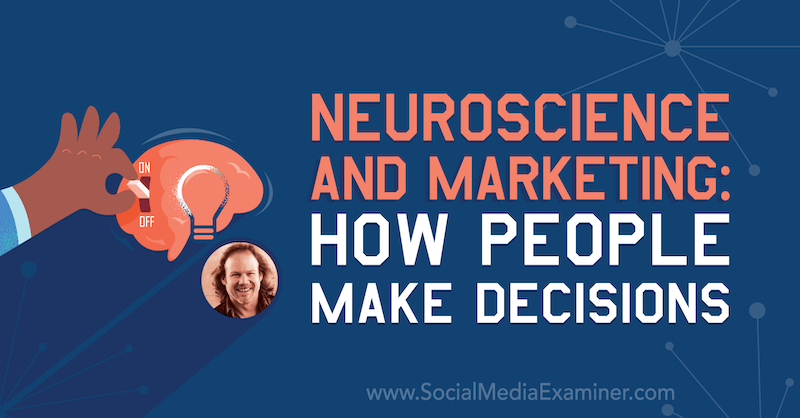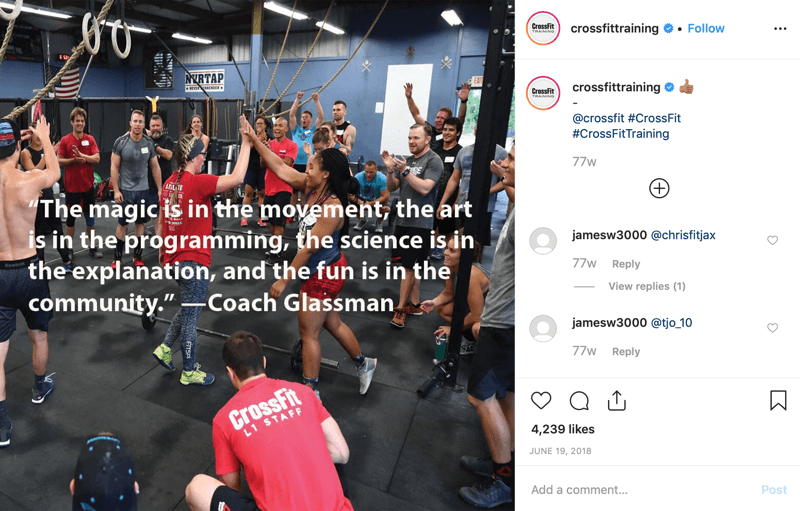Have you ever wondered why some marketing campaigns connect with people while others flop? Want insight into how the brain makes decisions that compel people to take action?
To explore the science behind how people make decisions, I interview Tracy Trost on the Social Media Marketing Podcast.
Tracy is a neuroscience marketing expert and the lead visionary at TCM Creative, where he creates fundraising commercials for non-profits. He's also a feature and documentary filmmaker who's worked in television for 30 years.
Tracy explains six principles of persuasion marketers should understand and how they can use concepts such as mirroring and anchoring in their messaging.
Listen to the Podcast Now
This article is sourced from the Social Media Marketing Podcast, a top marketing podcast. Listen or subscribe below.
Where to subscribe: Apple Podcasts | Spotify | YouTube Music | YouTube | Amazon Music | RSS

Understanding What Causes People to React or Take Action
Tracy has spent over 30 years in the marketing world and has found that the big question is always how to create something that will cause an audience to take action. Like many of us, Tracy didn't always realize that he was triggering people subconsciously. He just thought he was a great marketing guy who was able to hit on the right mix of pictures, copy, taglines, headlines, and other elements that caused the viewing audience to take notice.
About 6 years ago, sparked by curiosity about why people reacted to different marketing materials and not others, Tracy began exploring the neuroscience behind those reactions.
Tracy has always enjoyed talking to people, getting their stories, and really understanding what makes them tick. But it wasn't until he entered the world of non-profit fundraising, where ROI is measured down to the penny, that he started thinking about how he could refine his skills to the point where he could understand what causes someone to give when they see one commercial versus another.
Tracy noticed that he'd put out an ad that worked well but when he tried to create something similar, things wouldn't always work as well. That's when he started studying why people do what they do, and what's common to all of us that causes us to react or respond.
Tracy says that we as marketers ought to pay attention to neuroscience because we're using it all the time without even realizing it. When we have success, we pat ourselves on the back but then when we're asked to recreate that success, we don't really know what it was that worked.
We need to get an understanding of why people do what they do, and what causes them to react or take action. If we can have that “recipe” when we're creating our marketing materials, we can make sure that we've got those ingredients in there. Then we give ourselves the best possible chance of success. If we understand how our audience's brains work, we can be better marketers.
What Is Neuromarketing?
Think of your brain as a hard drive and your subconscious mind as your operating system. Your brain is always writing files when you're a young child. As you get older, sometimes you'll have a visceral reaction to something that someone says or does and you don't even know why.
Get World-Class Marketing Training — All Year Long!
Are you facing doubt, uncertainty, or overwhelm? The Social Media Marketing Society can help.
Each month, you’ll receive training from trusted marketing experts, covering everything from AI to organic social marketing. When you join, you’ll also get immediate access to:
- A library of 100+ marketing trainings
- A community of like-minded marketers
- Monthly online community meetups
- Relevant news and trends updates
To visualize this, if you put a snake in a room and you bring three different people into that room and show them the snake, you'll probably get three different reactions. One person may love the snake, another person may not really care about the snake, and another may freak out in terror. Same room, same snake; the difference is what each person believes about the snake on a subconscious level.
The terrorized person may consciously realize it's a common, harmless garden snake but the facts don't matter. Their subconscious, visceral process takes over and that subconscious belief determines how they react.
As adults, most of the decisions we make every day are based on what we believe, and most of those beliefs are based on things we were taught before we were 10 years old. Most of those decisions aren't based on fact; rather, they're based on what we subconsciously believe about something. We react versus respond.
It's important for marketers to understand this because it means our audience is going to react to our advertising materials more than they're going to respond. So if we get an understanding of what's common to most people in our audience and the things that regularly trigger people, we can write copy or make presentations designed to subconsciously cue people to react in the desired way.

Neuromarketing is a term Tracy uses to describe the process of creating marketing materials around what neurologically affects people on the subconscious level. It's marketing to their primal brain to trigger a subconscious reaction based on a belief. Emotions are responses to belief systems. Once you understand belief systems, you can tap into emotions.
Common Belief Systems Marketers Can Leverage in Neuromarketing
Tracy uses several subconscious belief systems in neuromarketing, some of which he discovered while studying Robert Cialdini's book, Influence, to help him better understand neuroscience. In the book, Cialdini covered six principles of persuasion, a few of which Tracy explains below.

The first is reciprocity. Here in the U.S., we've been socially conditioned to respond with a feeling of obligation if somebody does something for us. It's an inherent belief that anybody can tap into. For example, if Tracy was working with a veterans' service organization, he might write, “Our veterans have done so much for us. We owe it to them to do something nice.”

Discover Proven Marketing Strategies and Tips
Want to go even deeper with your marketing? Check out the Social Media Marketing Podcast! Publishing weekly since 2012, the Social Media Marketing Podcast helps you navigate the constantly changing marketing jungle, with expert interviews from marketing pros.
But don’t let the name fool you. This show is about a lot more than just social media marketing. With over 600 episodes and millions of downloads each year, this show has been a trusted source for marketers for well over a decade.
You can also use the principle of reciprocity with loss leaders. Sending people something for free now to get a sale later works because the recipient feels like they have an obligation to pay back a debt.
A second persuasive belief system is that of authority.
We've been conditioned to follow and listen to authority. That's why celebrities, politicians, and actors are frequently used in marketing. Often, people who use those authority figures in their marketing don't even understand why it works—they just know it does. If a figure who's respected by your audience says they should do something, they'll likely do it because they're subconsciously conditioned to follow authority.
Through his own work, Tracy has discovered the principle of unity: making people feel like they're a part of something. People who have a favorite football team will often say, “Oh man, we lost last week,” or “We killed it last week.” Those people have nothing to do with the football game but they identify with the organization, so they view the outcome of each game through the lens of “us” or “we.”
Put things in your marketing materials to make your target audience feel like they're a part of your organization or a tribe, or to make them believe other people are so they don't want to miss out.

To illustrate, Tracy added the line, “Please call now; if operators are busy, please call again” to some copy for a fundraising client. While the client wanted people to think that they'd be able to get through with no trouble, Tracy wanted people to think everybody else was calling so they experienced a heightened sense of urgency not to be left out.
How Chemical Reactions Impact Neuromarketing
Marketers also need to understand the physiological side of neuromarketing. There are several types of hormones released in our bodies when we experience certain things; for example:
- Oxytocin makes people feel good and is released when they feel a sense of security and connectedness.
- Serotonin is a comfort-related hormone.
- Cortisol is associated with stress and activates the fight-or-flight response.
- Dopamine is the reward hormone.
What does this mean for neuromarketing? You want your marketing to induce the release of the beneficial hormones. Tracy explains the effects of two of these hormones below.
Oxytocin
Your goal is to try to release oxytocin in the bodies of your prospect or target audience. Oxytocin is released by memories and when shared values are recognized. To activate those memories and values in your marketing, you need to go back to when your audience was younger than 10 years old and understand what life was like for them. Ask yourself:
- How was language used back then?
- What was the belief system?
- What was the world like?
- What were race relations like?
- What was their economic status at the time?
- Were we in a war during those times?

Once a customer or client is using your product or service, your messaging should continually share reasons that support someone's decision to do business with you. That's where mirroring neurons and dopamine come into play.
Mirroring and Dopamine
Mirroring is a behavior in which we subconsciously imitate (or mirror) the gestures, speech patterns, and attitudes of another “safe” person or authority. For instance, the way a baby will instinctively imitate dad flexing his muscles. It's why people walk, talk, and move a certain way.
Your subconscious brain says, “Yes, this is the right behavior because this is what your authority figure or your leader is doing in the tribe.” And when you mirror someone, dopamine is released.
To activate this in marketing, Tracy likes to show his potential client someone doing what he wants the prospect to do so the prospect mirrors the behavior. If he wants the prospect to go online and click on a button to buy a product or service, he'll actually show a phone that displays the URL in the hand of a person performing the action.

When the prospect mirrors the action, they get that dopamine hit. And once someone has made the decision to purchase your service or your goods, you can use mirroring to continually market to them—not by asking for more but by showing them what they did was the right thing to do.
Listen to the show to hear Tracy explain the concept of anchoring.
Key Takeaways From This Episode:
- Learn more about TCM Creative.
- Find out more about Tracy on tracytrost.com.
- Read Robert Cialdini's book, Influence.
- Watch Joe Dispenza on YouTube.
- Listen to Zig Ziglar's podcast.
- Learn more about what the brain does and why from Bob Proctor.
- Check out Social Media Marketing World 2020.
- Watch exclusive content and original videos from Social Media Examiner on YouTube.
- Watch our weekly Social Media Marketing Talk Show on Fridays at 10 AM Pacific on Crowdcast.
Help Us Spread the Word! Please let your Twitter followers know about this podcast. Simply click here now to post a tweet.
If you enjoyed this episode of the Social Media Marketing podcast, please head over to iTunes, leave a rating, write a review, and subscribe. And if you listen on Stitcher, please click here to rate and review this show.
What do you think? What are your thoughts on how neuroscience can be applied to marketing? Please share your comments below.
Attention Agency Owners, Brand Marketers, and Consultants

Introducing the Marketing Agency Show–our newest podcast designed to explore the struggles of agency marketers.
Join show host and agency owner, Brooke Sellas, as she interviews agency marketers and digs deep into their biggest challenges. Explore topics like navigating rough economic times, leveraging AI, service diversification, client acquisition, and much more.
Just pull up your favorite podcast app, search for Marketing Agency Show and start listening. Or click the button below for more information.

